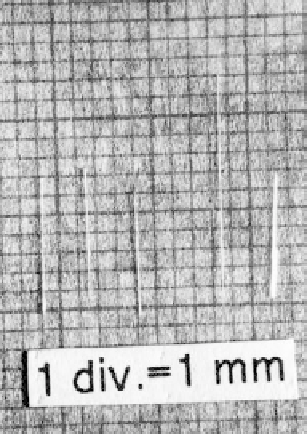Geoscience Reference
In-Depth Information
Figure 5.65 Carbonate-containing HAp single
crystals.
Source: Photo courtesy of A. Ito.
been held. The importance of this material as a biomaterial, composite material,
whiskers, fine particles, and so on are discussed in Chapter 10 and 11.
References
[1] S.I. Tomkeieff, On the origin of the name “quartz”, Min. Mag. 26 (1942) 172.
[2] R.B. Sosman, The Properties of Silica, American Chemical Society, Chemical
Catalogue Co., Inc., New York, NY, 1927.
[3] E.C.T. Chao, J.J. Fahey, J. Littler, D.J. Milton, Stisshovite, SiO
2
, a very high pressure
new mineral from meteor crater, Arizona, J. Geophys. Res. 67 (1962) 419
423.
[4] C.S. Ramsdell, The crystallography of “coesite”, Amer. Min. 40 (1955) 975.
[5] P. Wei, The structure of
α
-quartz, Zeit. Krist. 92 (1935) 355.
[6] W.H. Bragg, The X-ray spectra given by crystals of sulphur and quartz, Proc. Roy.
Soc. 89 (1914) 575.
[7] M. Hosaka, T. Miyata, I. Sunagawa, Growth and morphology of quartz crystals synthe-
sized above the transition temperature, J. Cryst. Growth 152 (1995) 300
306.
[8] J. Arndt, N. Rombach, Synthesis of coesite from aqueous solutions, J. Cryst. Growth
35 (1976) 28
32.
[9] T.I. Dyuzheva, L.M. Lityagina, N.A. Bendeliani, N.A. Nikolaev, G.I. Dorokhova,
Hydrothermal synthesis of coesite (SiO
2
), Crystallogr. Rep. 43 (1998) 511
513.
[10] T.F.W. Barth, The cristobalite structure: I high-cristobalite; II low-cristobalite, Am. J.
Sci. 23 (1932) 35024:97.
[11] X. Buisson, R. Arnaud, Hydrothermal growth of quartz crystals in industry, present sta-
tus and evolution, J. de Phesique IV, 4[C
2
] (1994) 25
32.


